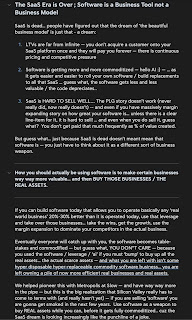Our LMS seem antiquated, a bare learning landscape of frustration, overloaded with outdated content a stockpile of cartoonish modules and tedious slideshows dotted with MCQs.
The market seems weary of simply renewing licences for software that has low use figures, often just slabbing out compliance content with no actual measurement of its productivity or impact. Measuring bums, even on virtual seats is to measure the wrong end of the learner.
These systems get locked in as a matter of habit not impact. But dreams don’t last forever and pricing on LMS software, content libraries and other learning services has got fiercely competitive. Many are seeing revenues plateau or fall. Management is being swapped out, share-prices falling, revenues no longer predictable, profits still showing overhang on 3 year licence fees. It has all become fiercely competitive.
AI is disruptor
Having been involved in a lot of AI projects for over a decade, since early 2014, the assumption has always been that people need to build some sort of AI SaaS product, sit back and watch the money pour in. A recent Tweet questioning this, by the much admired John Rush, went viral on this point.
Yet AI is already bringing services directly to your users, be it learners or employees in any sector at any level. With ChatGPTo1 reason has now appeared. AI now gives massive agancy to the individual separate from your corporate systems. Like a supercar at saloon prices it has overtaken many services on the fast lane. SaaS services get locked into fixed depreciating code. These inflexible code sets and fixed products make progress impossible, whereas AI seems to release new astounding updates on a weekly basis, so quick, it is hard to keep up.
AI is not really a business change, it is a change in mindset. You have to think of of power being plugged directoy into actual learners and employees. It releases agancy and motivation. Once you realise that everyone is using it, you need to see that its direct impact bypassing your existing systems.
AI on the SLY
The studies on productivity and impact are clear, that’s why most are using AI on the SLY. Individuals are increasing their productivity, making their lives easier, while organisations, locked into legacy systems are trying to ignore it or fighting it wit negativity. That’s because it needs a shift in mindset, to accept the probability game, understanding that everything has flaws, everyone is biased, especially people and processes. Sure AI may occasionally come up with the wrong answer but so do people and at least AI is fast! In fact, for most education, learning and business uses, hallucination is not a problem at all, as it has been pushed away out to the periphery. The appearance of reasoned ‘thinking’ has meant a whole load of new educational and organisational uses have been folded in to the omelette. And you don’t make an omelette without breaking eggs.
Productivity
Traditional Saas product in learning may be struggling but it also means that straight to user services in real time are alive and kicking ass.
One group of companies that are doing well are those that use AI to simply increase internal productivity. This gives them edge and the financial room to increase productivity or respond to pricing pressure. In one case we’ve seen astounding increases in productivity on process, both massive savings in time but also increases in quality. This gives you time to focus on customers and quality. How do you make your learning company more valuable? Get lean. Get agile. AI allows you build software fast. AI allows you to fast-track productivity increases. AI gives you quality increases fast. AI unleashes life in an organisation.
Performance support
Performance support, which is what 99% of AI is, is now in the hands of users. There’s tons of rooms for good delivery here, as organisations need to deliver performance support based on their own motherlode of content. In steps AI with RAG and other techniques to do precisely that - superbly well. Suddenly, you’re not relying on generic content, that everyone’s using, giving your organisation no edge at all. You can focus and lever what you already own.
Conclusion
We’re still locked into the lumbering LMS, often a dark dungeon of disappointment, also over-engineered content, often out of date and hopelessly cliched and generic, with its cartoon libraries and slideshows peppered with MCQs. There is a sense that the old era is dying in the vine, coming to an end.

No comments:
Post a Comment